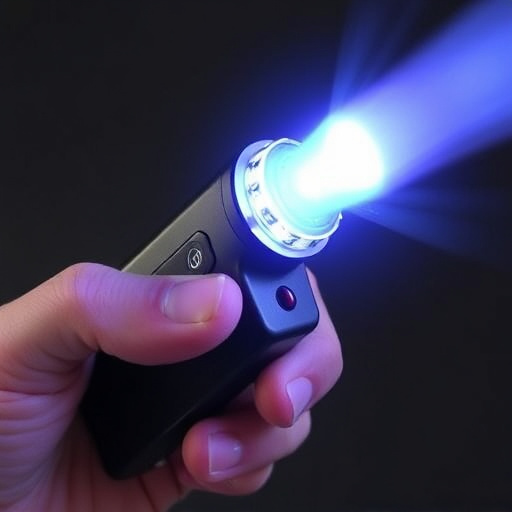Unveiling Stun Gun Design Secrets Through Current Spread Pattern Analysis
Understanding electrical current is vital for optimizing the performance, safety, and effectiveness…….
Understanding electrical current is vital for optimizing the performance, safety, and effectiveness of smart phone stun guns. The flow of electrons, influenced by material properties, component geometry, and interactions between conductors and insulators, creates complex patterns that engineers analyze to ensure user safety and enhance device effectiveness. Resistance plays a key role in current spread, impacting the stun gun's power and control. By studying current dispersion over targets, engineers can optimize impact areas for maximum stun effect with minimal collateral damage. This knowledge has led to innovative smart phone stun gun designs combining compactness with powerful stopping capabilities. Rigorous testing protocols ensure safe operating parameters, while future advancements in simulation tools promise to revolutionize stun gun design and electrical engineering.
Electrical current spread pattern analysis is a critical aspect of understanding how energy flows through conductive materials, especially in novel devices like smart phone stun guns. This insightful analysis reveals crucial insights into performance, safety, and design optimization. From the fundamental principles of electrical behavior to the intricate dynamics of resistance, this comprehensive guide explores how these factors influence the spread of current within stun gun devices. By delving into real-world applications, we uncover innovative approaches to enhance efficiency and mitigate risks associated with these powerful tools.
- Understanding Electrical Current and Its Behavior
- The Role of Resistance in Current Spread
- Analyzing Stun Gun Designs Through Pattern Analysis
- Safety Considerations and Future Prospects in Current Spread Pattern Analysis
Understanding Electrical Current and Its Behavior

Electrical current, a fundamental concept in physics and engineering, is the flow of charged particles, typically electrons, through a conductor. When applied to devices like a smart phone stun gun, understanding this behavior becomes crucial for safe and effective operation. The pattern of current spread within these weapons involves complex interactions between electrical properties of materials, geometry of components, and the presence of various conductors and insulators.
By analyzing how current flows and interacts with different parts of the stun gun—from the power source to the discharge terminals—engineers can optimize performance, ensure safety protocols, and even enhance the device’s effectiveness. This analysis is especially important as it helps in identifying potential risks associated with improper use and highlights critical design considerations for improving user safety.
The Role of Resistance in Current Spread

In the context of a Smart Phone Stun Gun, understanding the role of resistance in current spread is paramount. Resistance acts as a key factor in determining how an electrical current moves through a circuit or, in this case, the stun gun’s components. Higher resistance limits the flow of electrons, resulting in a lower current and potentially greater voltage at a given point. This principle is crucial when analyzing the stun gun’s effectiveness—a well-designed stun gun leverages resistance to ensure a strong electric shock without causing excessive damage to the target.
When a current spreads through various parts of the stun gun, resistance in different components can vary significantly. This variation directly influences where and how the current concentrates, ultimately affecting the device’s overall performance. By carefully managing resistance levels, manufacturers can optimize the stun gun’s ability to deliver a powerful, yet controlled, electric shock. This strategic approach ensures that the current is concentrated enough to incapacitate a target while minimizing the risk of permanent harm, similar to how a smart phone stun gun is designed for non-lethal self-defense applications.
Analyzing Stun Gun Designs Through Pattern Analysis

Analyzing the spread pattern of electrical current is a critical aspect of understanding and improving the effectiveness of stun guns, especially in designing modern devices like Smart Phone Stun Guns. By studying how jolts of electricity disperse over the surface of an object or target, engineers can optimize the device’s impact area, ensuring maximum stun effect with minimal collateral damage. This method allows for the creation of more precise and targeted non-lethal weapons, a significant advancement in personal safety technology.
Through pattern analysis, researchers can identify key factors influencing current distribution, such as the shape and material of the stun gun’s probe tips. They can then design or modify these components to control and direct the electrical flow, resulting in improved performance and safety features. This approach has led to innovations in Smart Phone Stun Guns, where compact designs meet powerful stopping capabilities, offering users a convenient yet effective personal defense solution.
Safety Considerations and Future Prospects in Current Spread Pattern Analysis

In the realm of electrical current spread pattern analysis, especially with devices like a smart phone stun gun, safety is paramount. As researchers and developers delve into enhancing these technologies, it’s crucial to navigate potential risks and ensure comprehensive testing protocols. Smart phone stun guns, for instance, utilize electric currents to incapacitate individuals temporarily, making accurate current spread pattern analysis vital. This involves understanding how electrical energy flows and disperses from the device to surrounding areas, helping to identify safe operating parameters and mitigate hazards like accidental shocks or over-current situations.
Looking ahead, future prospects in current spread pattern analysis promise revolutionary advancements. Smart phone stun gun technology, for example, could benefit from enhanced simulation tools that model current flow with unprecedented accuracy. These developments will enable more efficient design optimization, improve safety features, and potentially lead to innovative applications beyond personal defense. By integrating cutting-edge analytical methods, the field is poised to revolutionize not just stun gun design but also electrical engineering as a whole, ensuring safer technologies for everyday use.
Electrical current spread pattern analysis is a critical tool for understanding and optimizing the performance of smart phone stun guns. By delving into the behavior of current under various conditions, from resistance analysis to real-world design applications, we gain insights that can enhance safety and effectiveness. This knowledge not only informs the development of more robust stun gun designs but also underscores the importance of continuous research in this field, paving the way for future innovations that prioritize user safety.


